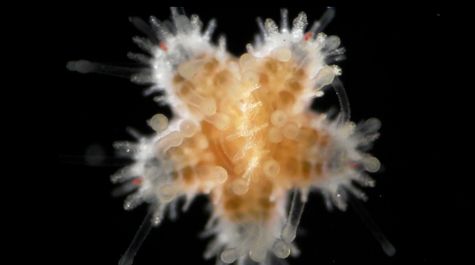
Baby sea stars may look innocent and adorable, but they're teensy little cannibals and eat their own siblings for their own survival, according to a new study.
Two researchers discovered this behavior among baby Forbes' sea stars (Asterias forbesi) by accident. They were originally trying to understand how baby sea stars reacted when introduced to ferocious crab predators in the lab.
"But they all started eating each other before we even introduced the crabs. So we had to scrap that experiment," Jon Allen, associate professor in William & Mary's Department of Biology, said in a statement. So Allen and his team shifted gears to observe this previously unknown phenomenon among the baby sea stars.
Related: Dangers in the deep: 10 scariest sea creatures
The Forbes' sea stars, which are commonly found on the East Coast of the U.S., can reach between 4.7 and 9.4 inches (11.9 and 24 centimeters) in length as adults, according to National Geographic. Juvenile sea stars are basically pinhead-size versions of their parents, Allen said. These sea stars undergo a process called metamorphosis in which they transform from an immature form to an adult form just as caterpillars transform into butterflies.
These sea stars, in their immature larval form, look like "weird little spaceships" flying through the water, said Karina Brocco French, a doctoral student at the University of California, Irvine (who was an undergraduate student working in Allen's lab during this research). They stay in this weird-little-spaceship stage for about a month before they metamorphosize into juvenile sea stars and settle on the seafloor, Brocco French said in the statement.
Scientists already knew that juveniles on the seafloor would eat the much-smaller larval forms sinking to the bottom — but they didn't realize that juveniles would eat each other. Still, even though the juveniles are roughly the same size as one another, the slightly bigger ones always ended up eating the smaller ones, according to the statement.
French and Allen discovered that the baby sea stars engaged in this cannibalistic behavior as early as four days after metamorphosing. They did so using one of their multiple stomachs, known as their "cardiac stomach," which they push out to engulf and break down their food.
Sibling cannibalism might give the individual stars an adaptive advantage, especially since adult female sea stars produce 5 million to 10 million eggs a year, Allen said.
While such behavior was unknown in this species, cannibalism is not uncommon in the animal kingdom, with more than 1,300 species (including humans) documented to exhibit it, according to the statement. And the researchers think that cannibalism is likely to be even more widespread among small animals, including juveniles.
The findings were published on March 26 in the journal Ecology.
Originally published on Live Science.
Hungry baby sea stars eat each other in unexpected case of underwater cannibalism - Livescience.com
Read More

No comments:
Post a Comment